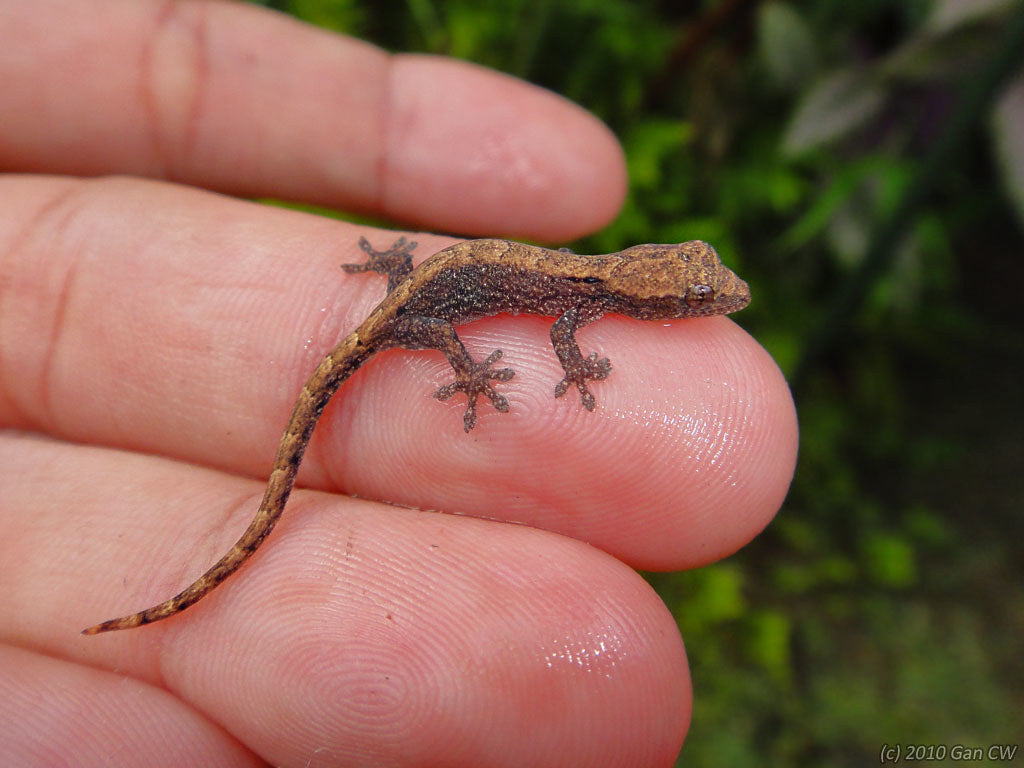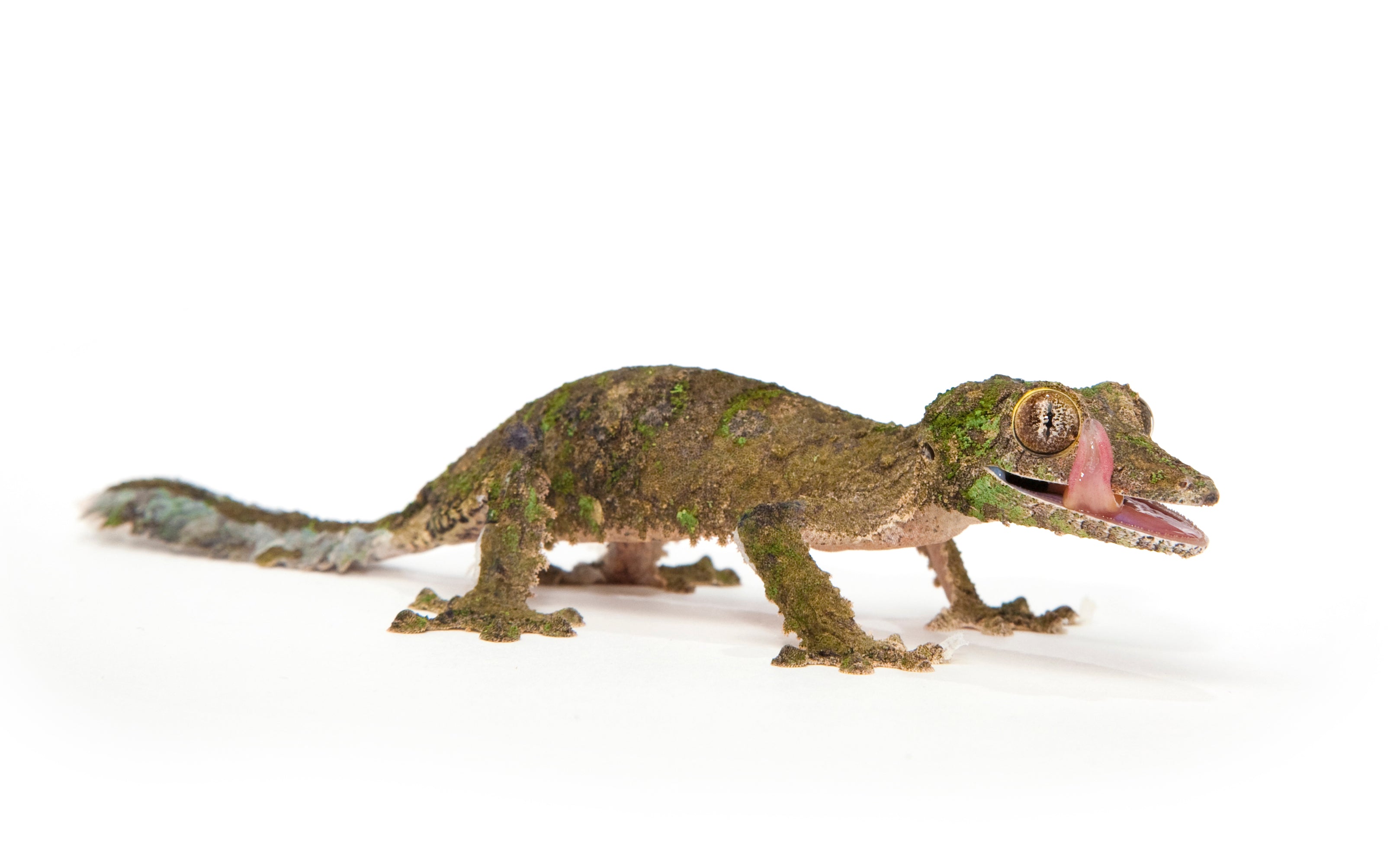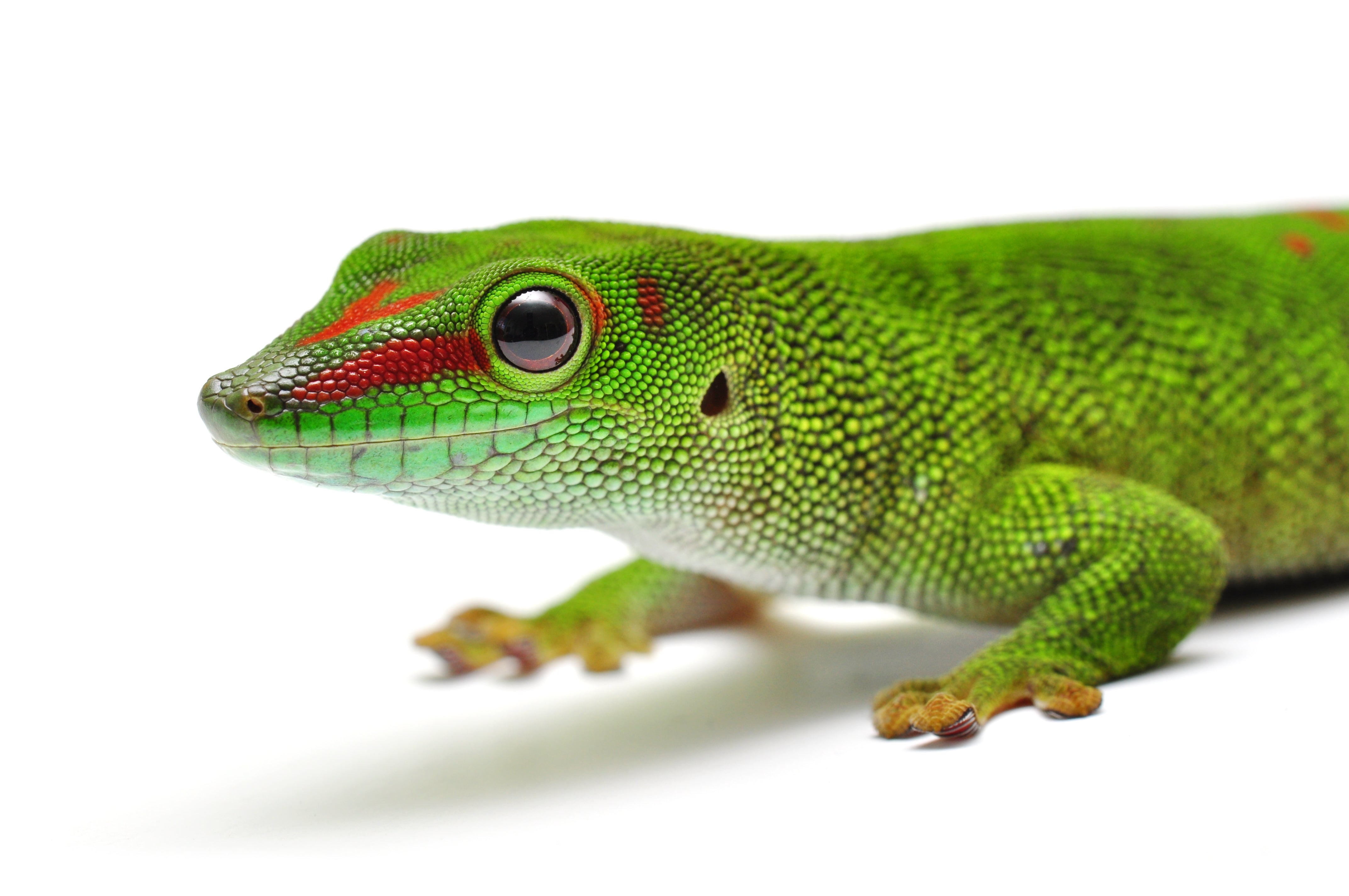Mourning geckos (Lepidodactylus lugubris) are 3-4” long, nocturnal, arboreal geckos native to the Indo-Pacific coast, including but not limited to Hawaii, Indonesia, and Australia. They are very adaptable, but their preferred habitat is temperate rainforest.
Mourning geckos are tiny, fine-featured geckos with a tan background color, pale belly, and darker brown to black markings. Like other arboreal geckos, they have sticky toepads and do not have eyelids.
Something that makes these geckos unique is that they are parthenogenetic, which means that they are all female and reproduce without mating with a male. Because of their potential for exponential multiplication, and lack of handleability, mourning geckos are an intermediate-level pet.
How much space do mourning geckos need?
Mourning geckos may be tiny, but they’re still quite active and need an enclosure that is large enough to allow them to thermoregulate and exercise other natural behaviors. A group of 2-4 mourning geckos should be housed in absolutely no smaller than a 12”L x 12”W x 18”H terrarium, although larger is strongly recommended for the following reason:
Mourning geckos are a social species that typically live in family groups with an organized social structure, so it’s best to never house them alone. Most keepers start with two, and since they’re parthenogenic, they slowly multiply over the months and years on their own. Unless you have a strategy for population control, it’s best to start with a larger enclosure and let the geckos fill it on their own rather than try to catch them all and upgrade later.
Do mourning geckos need UVB?
They can survive without it with the right supplementation, but considering that they are constantly producing eggs, it’s best practice to use UVB with this species. UVB gives them all of the vitamin D that their bodies need for proper calcium metabolism, stimulates better appetite and activity, and generally allows them to be healthier than they would be without. Despite their nocturnal nature, metabolic bone disease is surprisingly common among mourning geckos kept without UVB.
We recommend the 26w Zoo Med ReptiSun 5.0 Compact Fluorescent UVB bulb for mourning geckos housed in a 12” x 12” x 18” terrarium. Using a larger enclosure will require a larger bulb to provide adequate coverage.
The UVB bulb should be housed in a reflective fixture and placed close to the heat lamp. UVB is blocked by glass and plastic, so you can’t give your gecko UVB by placing its terrarium in front of an open window. Also make sure that the fixture your UVB bulb is in does not have a clear plastic bulb cover.
Mourning geckos should receive 12 hours of light per day.
What basking temperatures do mourning geckos need?
Despite popular myth, mourning geckos do benefit from having a basking area. After all, they’re still ectotherms, which means that they need a temperature gradient in their enclosure to help them regulate their metabolism and stay healthy.
Mourning geckos should have a low basking temperature between 82-85°F, as measured by a digital probe thermometer with the probe placed on the basking surface. The cool zone in the lower regions of the enclosure should stay between 70-75°F. Heat lamps should be turned off at night. Nighttime temperatures can drop as low as 65°F.
Provide heat for your geckos by imitating the sun with a low-wattage incandescent bulb placed on one side of the enclosure. Do not use ceramic heat emitters (CHEs), red bulbs, or blue bulbs, as these are not as effective. Because mourning geckos have a tendency to climb upside-down on the underside of the mesh, you will need to prevent potential burns by raising the heat lamp at least 1-2” above the mesh with a lamp stand or shims.
What humidity levels do mourning geckos need?
Mourning geckos need a high humidity environment with an average humidity of 60-80%, as measured by a digital probe hygrometer with the probe in the middle of the terrarium.
Misting your geckos’ enclosure with a sprayer first thing in the morning and again at night will help create the right humidity levels. It also provides an important source of drinking water! Using live plants as part of the decor, rather than artificial plants, is also very helpful for maintaining humidity.
What substrate is good for mourning geckos?
Although mourning geckos are an arboreal species and don’t spend much time on the ground, placing a layer of substrate on the floor of the enclosure helps maintain humidity. As an added perk, it also tends to make the enclosure more attractive.
Ideally, this substrate should resemble what mourning geckos naturally live on in the wild — in this case, tropical soil. It should have small particles and hold moisture well. We recommend the following substrates for mourning geckos:
Layering clean, chemical-free leaf litter on top of the substrate can also help with humidity.
Substrate should be at least 2” deep and completely replaced every 3-4 months. Remove poop and urates daily, along with contaminated substrate.
What décor can you use in a mourning gecko terrarium?
It’s terribly boring for your geckos to be stuck in an enclosure with nothing in it except substrate and food/water bowls. It doesn’t matter how big the enclosure is if you don’t put things in it for your pets to use and interact with.
Mourning geckos appreciate a fairly densely planted enclosure with either live or artificial plants, which can make their terrarium a great piece of home decor! You may be worried about never seeing them if they have plenty of places to hide, but just the opposite holds true: the more hiding places they have, the more likely you are to see your geckos since they will feel more secure.
Here are some décor ideas:
- branches and vines
- cork tubes
- ledges
- live or artificial plants
What do mourning geckos eat?
Mourning geckos are omnivorous, which means that they need to eat a balanced diet of plant and animal matter in order to get the nutrition that their bodies need. In the wild, they primarily eat insects, flower nectar, and fruit. In captivity, it’s best to feed them high-quality, specially-formulated crested gecko diet (CGD) supplemented by live insect feeders.
Mourning geckos do well on a diet of crested gecko diet (replaced every 24-48 hours) and calcium-dusted insects 1-2x/week. Crested gecko diet should be offered in a small cup mounted on the wall of the enclosure, rather than the floor, as this makes it more accessible.
Best crested gecko diets: Pangea, Repashy, Leapin’ Leachie, Zoo Med, Lugarti, Black Panther Zoological, Gecko Pro
Feeder insects for mourning geckos: newborn dubia roach nymphs, newborn discoid roach nymphs, red runner roach nymphs, pinhead crickets, fruit flies, hatchling snails
Remember, the key to great nutrition is variety!
Supplements
Although crested gecko diet doubles as a vitamin supplement, you will need calcium powder to dust on feeder insects. We recommend Repashy Supercal NoD.
Water
Although your geckos will get most of their drinking water from daily mistings, it’s a good idea to also provide a wall-mounted water dish. Change the water daily and scrub the bowl with a reptile-safe disinfectant weekly, or whenever it becomes soiled.
Do mourning geckos like to be handled?
Not at all, and they are too small and fast to be safely handled anyway. These are a look-but-don’t-touch kind of pet!
*This care sheet contains only very basic information. Although it’s a good introduction, please do further research with high-quality sources to obtain additional information on caring for this species. Here are some other great sources to read:
(photo credit DW.com)




Leave a comment
This site is protected by hCaptcha and the hCaptcha Privacy Policy and Terms of Service apply.